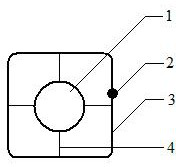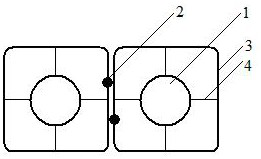Electronic demonstration model of covalent bond forming molecules
An electronic, covalent bond technology, applied in the field of chemistry teaching demonstration models, can solve the problems of lack of corresponding teaching aids and demonstration devices, and achieve the effect of simple structure, obvious phenomenon, and increasing learning interest
- Summary
- Abstract
- Description
- Claims
- Application Information
AI Technical Summary
Problems solved by technology
Method used
Image
Examples
Embodiment 1
[0018] Example 1 (see image 3 ): A magnetic ball 2 is inserted on the rounded square iron wire 3, and a hydrogen atom symbol with an orange background color is pasted on the circular magnetic iron sheet 1. Two similar devices are close to each other, indicating that two hydrogen atoms share A pair of electrons, which in turn demonstrates the nonpolar covalent bond contained in the hydrogen molecule.
Embodiment 2
[0019] Example 2 (see Figure 4 ): five magnetic balls 2 are inserted on the rounded square iron wire 3, and a nitrogen atom symbol whose background color is dark blue is pasted on the magnetic iron sheet 1; two similar devices are close to each other, and each side has three A magnetic sphere 2, which shows that two nitrogen atoms share three pairs of electrons, and then shows the non-polar covalent bonds contained in nitrogen molecules.
Embodiment 3
[0020] Embodiment 3 (see Figure 6 ): insert a magnetic ball 2 on the rounded square iron wire 3, paste the hydrogen atom symbol with orange background color on the magnetic iron sheet 1; insert seven magnetic balls on another rounded square iron wire 3 2. A chlorine atom symbol with a green background color is pasted on the magnetic iron sheet 1. The two devices are close to each other, and there are two magnetic balls 2 on the side close to each other, which means that the hydrogen atom and the chlorine atom share a pair of electrons. , which in turn demonstrates the polar covalent bonds contained in the HCl molecule.
[0021] In summary, with this device, the covalent bonds between small molecules such as simple molecules, hydrides, and oxides that are common in middle school chemistry can be displayed and inspired, allowing students to deepen their understanding of abstract concepts during hands-on operations, increasing their Interesting, deepens the impression, and make...
PUM
 Login to view more
Login to view more Abstract
Description
Claims
Application Information
 Login to view more
Login to view more - R&D Engineer
- R&D Manager
- IP Professional
- Industry Leading Data Capabilities
- Powerful AI technology
- Patent DNA Extraction
Browse by: Latest US Patents, China's latest patents, Technical Efficacy Thesaurus, Application Domain, Technology Topic.
© 2024 PatSnap. All rights reserved.Legal|Privacy policy|Modern Slavery Act Transparency Statement|Sitemap



